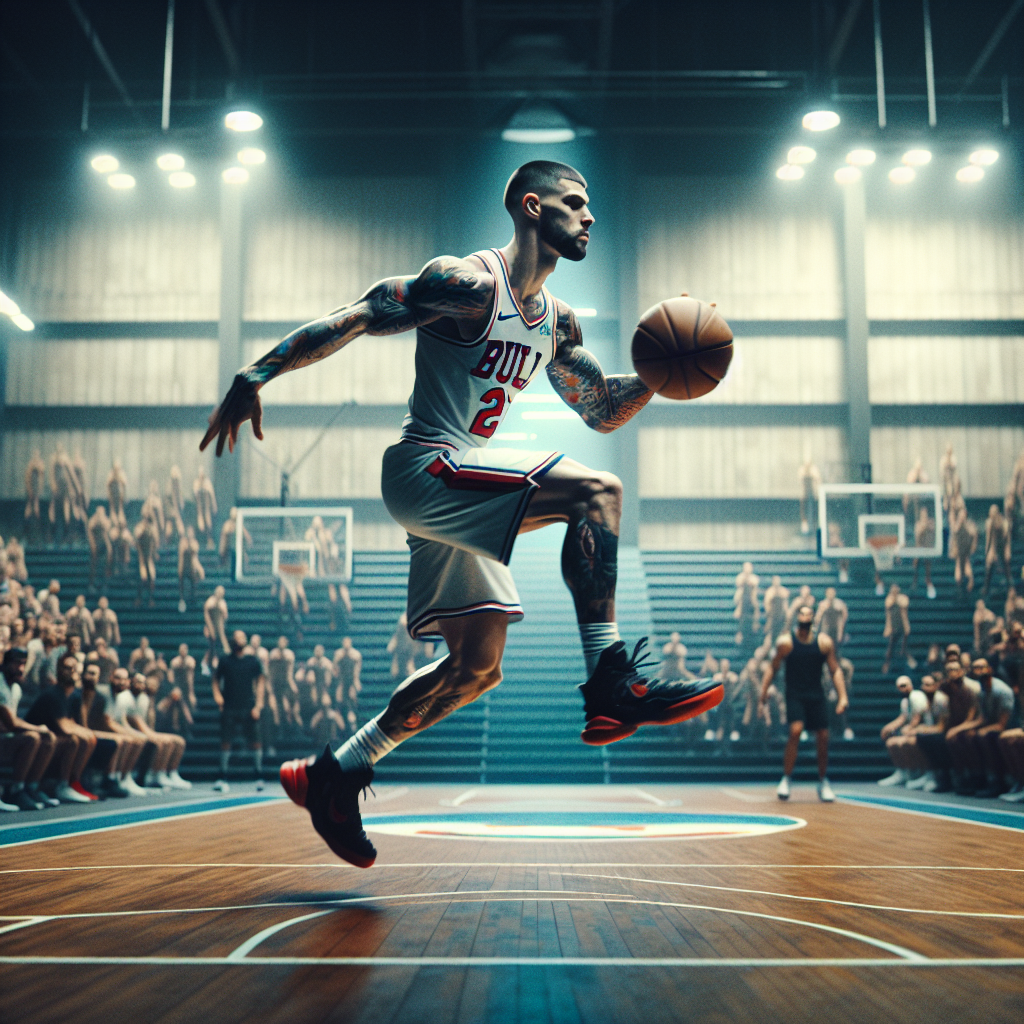Zach LaVine doesn’t have a trade market currently

Why Zach LaVine’s Trade Market Has Dried Up
Zach LaVine, a dynamic shooting guard known for his scoring prowess and athleticism, has found himself in an unexpected predicament: a lack of interest in the trade market. This situation is surprising, given LaVine’s impressive individual statistics and highlight-reel performances. However, several factors contribute to the current stagnation in his trade value, making it a complex issue that extends beyond mere on-court performance.
Firstly, LaVine’s contract plays a significant role in the hesitancy of potential suitors. In 2022, he signed a five-year, $215 million max contract extension with the Chicago Bulls. While this deal underscores his value to the franchise, it also makes him a costly acquisition for any team considering a trade. The financial commitment required to absorb such a substantial contract can be daunting, especially for teams already navigating the complexities of the salary cap. Consequently, only a handful of franchises have the financial flexibility to entertain such a move, and even fewer are willing to take on the associated risks.
Moreover, LaVine’s defensive liabilities have raised concerns among potential trade partners. While he is undoubtedly an offensive juggernaut, averaging over 24 points per game in recent seasons, his defensive metrics have often been subpar. In an era where two-way players are highly coveted, LaVine’s one-dimensionality on the defensive end can be a significant deterrent. Teams aiming for deep playoff runs prioritize defensive solidity, and LaVine’s perceived shortcomings in this area make him a less attractive option.
In addition to his defensive issues, LaVine’s injury history cannot be overlooked. Over the years, he has dealt with various injuries, including a significant ACL tear in 2017. Although he has shown resilience and an ability to bounce back, the specter of potential future injuries looms large. Teams are understandably cautious about investing heavily in a player with a history of significant injuries, fearing that his availability could be compromised at crucial moments.
Furthermore, the current landscape of the NBA trade market is another contributing factor. The league is experiencing a period of relative parity, with many teams believing they are just a piece or two away from contention. This competitive balance means that franchises are more judicious in their trade considerations, often preferring to develop their existing talent or seek out more cost-effective acquisitions. In such an environment, the allure of trading for a high-cost player like LaVine diminishes.
Additionally, the Chicago Bulls’ own stance on LaVine complicates matters. The organization has expressed a desire to build around him, viewing him as a cornerstone of their future. This commitment signals to other teams that prying LaVine away from Chicago would require a substantial offer, likely involving multiple assets and draft picks. The high asking price further dissuades potential trade partners, who may be unwilling to mortgage their future for a player with the aforementioned concerns.
In conclusion, Zach LaVine’s current lack of a trade market is the result of a confluence of factors. His hefty contract, defensive limitations, injury history, the competitive nature of the NBA, and the Bulls’ high valuation of him all contribute to the present situation. While LaVine remains a talented and electrifying player, these complexities have collectively dampened the enthusiasm of potential trade suitors, leaving him in a state of trade limbo.
Factors Contributing To Zach LaVine’s Lack Of Trade Interest

Zach LaVine, a prominent figure in the NBA, has recently found himself in an unexpected situation: a lack of trade interest. This development is surprising given his impressive on-court performances and athletic prowess. Several factors contribute to this current state of affairs, each playing a significant role in shaping the market’s perception of LaVine.
Firstly, LaVine’s contract is a primary consideration. He signed a five-year, $215 million max contract extension with the Chicago Bulls, which, while reflective of his value, also makes him a costly acquisition. Teams must weigh the financial implications of absorbing such a substantial contract, especially under the constraints of the NBA’s salary cap. This financial burden can deter potential suitors who may be unwilling or unable to commit to such a significant expenditure.
Moreover, LaVine’s injury history cannot be overlooked. Although he has demonstrated resilience and a strong return to form, his past injuries raise concerns about his long-term durability. Teams are cautious about investing heavily in a player who may be prone to future health issues. This apprehension is particularly relevant in a league where the physical demands are relentless, and the margin for error is slim.
In addition to financial and health considerations, team dynamics and fit are crucial factors. LaVine is a high-usage player who thrives with the ball in his hands. While his scoring ability is undeniable, integrating him into a new team’s existing structure can be challenging. Teams with established stars or specific offensive systems may hesitate to disrupt their chemistry by introducing a player who requires significant touches and offensive freedom. This potential disruption can be a deterrent, as teams strive to maintain cohesion and balance.
Furthermore, the current state of the NBA market plays a role. The league is experiencing a period of relative stability, with many teams having already made significant roster moves in recent seasons. Consequently, there is less urgency for blockbuster trades, and teams are more inclined to develop their existing talent. This environment reduces the demand for high-profile trades, leaving players like LaVine in a less favorable position.
Additionally, the Bulls’ own stance on trading LaVine influences the market. Chicago’s management may have set a high asking price, reflecting their valuation of LaVine’s talent and potential. This high demand can deter teams from engaging in trade discussions, as they may be unwilling to part with the assets required to meet the Bulls’ expectations. The combination of a high asking price and the factors mentioned earlier creates a challenging landscape for any potential trade.
Lastly, the perception of LaVine’s impact on winning is a subtle yet significant factor. While his individual statistics are impressive, there is ongoing debate about his ability to elevate a team to championship contention. Teams are increasingly analytical, considering not just raw talent but also a player’s overall contribution to team success. This nuanced evaluation can influence trade interest, as teams seek players who can make a tangible difference in their pursuit of titles.
In conclusion, Zach LaVine’s lack of trade market interest is a multifaceted issue. His substantial contract, injury history, fit within team dynamics, the current NBA market environment, the Bulls’ high asking price, and perceptions of his impact on winning all contribute to this complex situation. As the NBA landscape continues to evolve, it remains to be seen how these factors will influence LaVine’s future and whether a trade market will eventually materialize.
Analyzing The Decline In Zach LaVine’s Trade Value
Zach LaVine, once considered one of the most electrifying players in the NBA, now finds himself in a peculiar situation where his trade value has significantly diminished. This decline in trade interest is not only surprising but also indicative of several underlying factors that have contributed to this unexpected turn of events. To understand why LaVine’s trade market has cooled, it is essential to examine the various elements that have influenced this shift.
Firstly, LaVine’s performance on the court has been inconsistent over the past few seasons. While he has shown flashes of brilliance, his overall impact has been marred by bouts of inefficiency and defensive lapses. Teams looking to acquire a player of LaVine’s caliber are often seeking a consistent and reliable contributor, and his fluctuating performance has raised concerns about his ability to fulfill that role. This inconsistency has undoubtedly played a role in diminishing his trade value.
Moreover, LaVine’s injury history cannot be overlooked. He has dealt with significant injuries throughout his career, including a torn ACL in 2017. Although he has made a commendable recovery, the lingering concerns about his long-term durability have made potential suitors wary. In a league where the physical demands are relentless, teams are cautious about investing in a player with a history of serious injuries. This apprehension has further contributed to the lack of a robust trade market for LaVine.
In addition to his on-court performance and injury history, LaVine’s contract situation has also played a pivotal role in the decline of his trade value. He is currently under a lucrative contract, which, while reflective of his talent, poses a significant financial commitment for any team considering a trade. The salary cap constraints and luxury tax implications make it challenging for teams to absorb such a contract without compromising their financial flexibility. Consequently, this financial burden has deterred potential trade partners from pursuing LaVine.
Furthermore, the evolving landscape of the NBA has influenced the perception of LaVine’s value. The league has seen a shift towards prioritizing versatile, two-way players who can contribute on both ends of the floor. While LaVine is undoubtedly a gifted scorer, his defensive shortcomings have been a point of contention. Teams are increasingly valuing players who can impact the game in multiple facets, and LaVine’s one-dimensional skill set has made him less appealing in this context.
Additionally, the emergence of younger, cost-effective talent has also played a role in diminishing LaVine’s trade market. Teams are constantly on the lookout for emerging stars who can be developed and integrated into their long-term plans. The influx of young talent through the draft and player development programs has provided teams with alternative options that are both financially viable and promising in terms of potential. This shift in focus towards younger players has inadvertently impacted the demand for established stars like LaVine.
In conclusion, the decline in Zach LaVine’s trade value can be attributed to a combination of factors, including his inconsistent performance, injury history, contract situation, evolving league dynamics, and the emergence of younger talent. While LaVine remains a talented player with the potential to make a significant impact, these elements have collectively contributed to the current lack of a robust trade market for him. As the NBA landscape continues to evolve, it will be interesting to see how LaVine’s situation develops and whether he can regain the trade value he once commanded.

